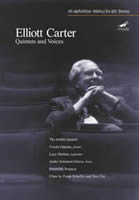Elliott Carter on the Big Screen
|
Grant Chu Covell [December 2004.] Elliott Carter passed through these parts when, last month, the Boston Symphony Orchestra performed the composer’s Micromicón and Symphonia. Unfortunately, I missed the performances but did catch Frank Scheffer’s Carter film, A Labyrinth of Time, screened in Carter’s presence at the end of a Harvard University conference on his orchestral music. A Labyrinth of Time is a wonderful, loving portrait. Bypassing metric modulation, all-interval chords and other Carter preoccupations, Scheffer centers on several cities that influenced the composer, including Paris, Berlin and of course New York. Ives and Varèse tunes accompany prewar New York footage as Carter recalls his boyhood. We see Carter relaxing in Montmartre after having visited the school where Nadia Boulanger taught counterpoint and analysis. In postwar Berlin, numbed bystanders watch the rising Wall; later we see the glittering opera house. As Carter reflects on modern concerns (technology speeding everyday tasks, diverse ethnicities in close proximity), we return to a bustling New York, Scheffer capturing its bridges, skyscrapers and self-absorbed pedestrians with a dispassionate eye and a hint of Koyaanisqatsi. Vignettes with Daniel Barenboim and Pierre Boulez offer pointed European views on American culture, which Carter paradoxically represents and supersedes. Barenboim articulates the irony that civilized Berlin’s final 20th-century opera, Carter’s What Next?, was written by someone from popcorn and pop music’s birthplace. Boulez dismisses much American music for its intentional simplicity. Charles Rosen and several iterations of the Arditti Quartet also appear. Revealing moments include Carter gently hectoring pianist Ursula Oppens, who fails to launch the Piano Concerto to the composer’s satisfaction. He faults her opening solo’s second note from which the concerto’s dreaminess springs. Oppens seems baffled but deferential. Elsewhere Carter and Boulez discuss the Clarinet Concerto’s dynamics. Carter would have the Ensemble InterContemporain take a passage quieter so that soloist Damiens can produce a proper p. This leads to generalities about ineffectively notated dynamics wherein Boulez admits to correcting Berg’s primary voices when they are marked softer than secondary ones. Carter asks whether le maître ever considered why composers make such decisions. Boulez retorts that he does not. Carter’s discomfort is evident throughout the exchange. Some scenes linger on Scheffer’s aesthetic willfulness. A handheld camera attempts to focus through Carter’s own glasses and onto a manuscript sheet on which the composer is working. A barge on the Hudson slips under a bridge and we’re suddenly quayside to the Seine. Carter’s New York apartment, spanning 25 years, is the film’s locus. Throughout and to his great credit, Carter hardly looks a day over 60. We see him pushing a pencil (frequently the eraser end) and rehearsing Figment No. 2 — for Mr. Ives with cellist Fred Sherry. We pause over Helen Carter’s sculptures (heads and figures in a Giacometti / Noguchi style), and she modestly defends suppressing her creative energies to keep the household in order so her husband could compose. “[But] … I make the beds,” Carter proudly admits, his eyes twinkling mischievously. It’s touching to see her fussing over newspapers and making tea for guests. Helen died in 2003, at 95. Carter’s windows frame sunny, rainy, foggy and snowy views of Lower Manhattan. Dripping rain provides an apt counterpoint to Carter’s music. We see the composer making his way to the Brooklyn Bridge for a stroll, discussing the poet Hart Crane, whom Carter admired. Near the film’s close, the World Trade Center’s towers, once taken for granted, are no longer there.
Scheffer’s other projects include conductors laboring over contemporary scores and composer-specific films (Cage, Stravinsky, Zappa and others), one of which captures the circus atmosphere of Stockhausen’s Helikopter String Quartet. Scheffer’s four Cage films are on mode 140. The label hopes soon to distribute A Labyrinth of Time. Meanwhile, mode 128’s DVD version offers Scheffer’s untraditional take on Carter’s 1997 Quintet for Piano and Strings with Ursula Oppens and the Arditti Quartet. The camera moves asynchronously with the score, with Scheffer’s lens sliding around and amidst the quintet, pinning one player in the background as another blurs in the foreground. These are not musicians’ views so much as those of a creatively puzzled interloper. Lights above and below dim and flare to no discernable pattern. I’m not certain this is better than an audience’s perspective. Even at the fourth go-round, one is distracted by one’s attempt to make sense of Scheffer’s dramaturgy. However, if this helps folks “get” Carter — whose music flowers on repetition — I’m all for it.
[More Grant Chu Covell]
[More
Carter]
[Previous Article:
The Listening Room]
[Next Article:
To Stand or Not to Stand]
|
